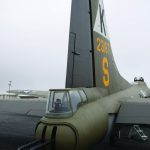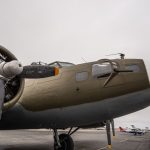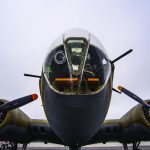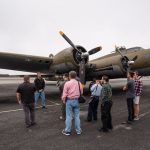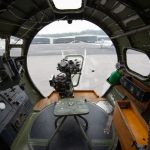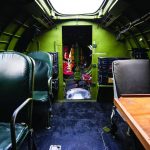Written by Gina Castro | Photos by Guy Stevens
In 1943, just four days before Christmas, a badly damaged B-17 Bomber piloted by 21-year-old 2nd Lieutenant Charlie Brown flew over Nazi Germany. Half of Brown’s nine-men crew were wounded or dead. This was their first mission. Then suddenly a moment commonly referred to as “the most incredible encounter between enemies in World War II” took place. One of the most advanced fighters of the era pulled up on the bomber’s tale. It was a German Messerschmitt fighter piloted by 22-year-old 2nd Lieutenant Franz Stigler. Stigler was a former airline pilot from Bavaria who never intended to fight in World War II. In an incredibly act of bravery, Stigler chose to spare Brown and his crews’ lives by escorting the B-17 out of Germany, which was a treasonous action in Germany. Once the bomber was out of harm’s way, the German fighter pilot saluted and turned to fly home. Stigler did that heroic action with the knowledge that if he were caught, he would have to face a firing squad. The two pilots met 40 years later and remained friends up until they passed away.
Today, that B-17, now named “Ye Olde Pub,” tours the country to tell this amazing, true story. Ye Olde Pub is flown and restored by the Liberty Foundation, a 501C3 nonprofit. The Liberty Foundation works to raise donations for these WWII planes to keep flying instead of wearing away in a museum.
“We hope to keep the airplanes going. The foundation’s plan is to keep these airplanes hopefully out of museums,” Ray Fowler, a combat-veteran F-16 fighter pilot in the Air National Guard and Liberty Foundation volunteer pilot, said. “It’s getting harder and harder because the costs are so high, and I think this year, you’re going to see several of these airplanes, and possibly even this airplane, go off because the insurance is getting to be so expensive to keep them in the air.”
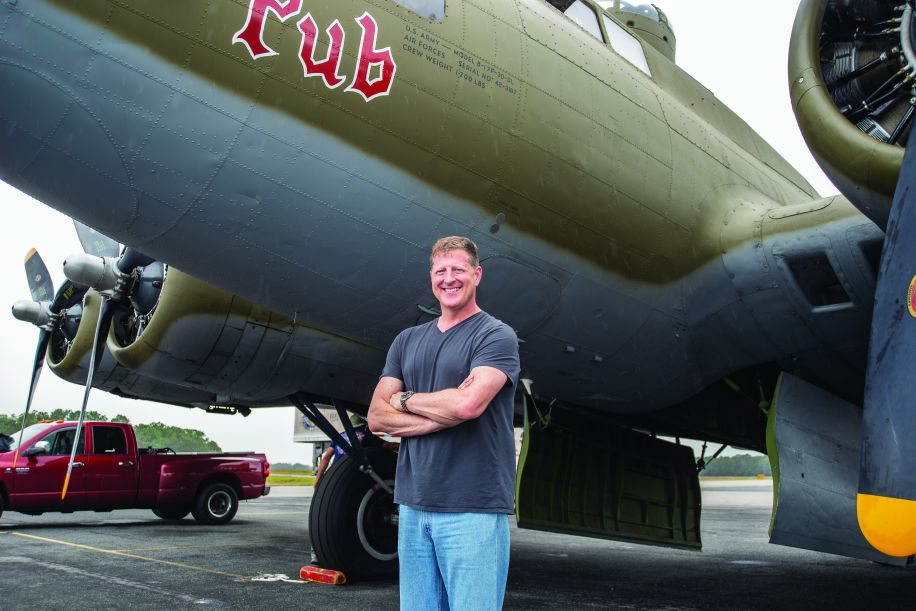
Fowler said that the insurance for this plane is $200,000 alone, and the gas in the B-17 is 200 gallons and hour. The B-17 can hold up to 1,700 gallons of gas. This plane has four engines, which are about 60,000 dollars a piece, and you get 1,400 hours out of the engines. Each engine gets 40 gallons of oil, which totals to 160 gallons of oil. Since the radial engines are not very efficient, they burn a lot of oil and gas.
“If you flew it one hour, that’d be more than $200,000 an hour,” Fowler said. “The more we can fly the airplane, the more we can divide out the overall cost.”
The Liberty Foundation is touring the country with the Ye Olde Pub and a P-51, which is described as “the sports car of the sky.” People can experience what it’s like to fly in one or both of these planes. Liberty Foundation has already visited Pensacola, but you can go to LibertyFoundation.org for their complete tour schedule.
Fowler said that the B-17 is historically the most famous bomber that’s ever been built. It was great for daylight bombing, but a lot of lives were lost in B-17s. “To just think of the numbers, over 50,000 airmen were either killed in action, missing in action or prisoners of war just in the B-17 alone,” Fowler said. “It had a crew of 10, and every time one was shot down, that was ten men that went down in the airplane. Early in the war, two out of three airplanes would be shot down in any given mission. They built 12,732 of them. Now there’s less than a dozen flying.”
Fowler described what it was like to fly in a B-17 bomber during WWII. Each B-17 had a total of 10 crew members. The plane would fly at 30,000 feet on oxygen, and the temperature is 40 below zero. The planes were not pressurized, so the crew would wear electric suits to keep warm. The military didn’t want to weigh the plane down by adding bullet proofing to protect the crew, so the plane’s walling is paper thin. “Everything was about fuel, bombs and bullets on this airplane to get it to the target,” Fowler said.
Once the plane was in flight, the crew had to stay in position. The only positions who had seats were the pilot, the bombardier, navigator and radio controls. The other six crew members had to sit on metal, and missions could be anywhere between six to 10 hours long. The father of Don Brookes, the founder of the Liberty Foundation, was a tailgunner. A tailgunner is the person who shoots from the very back of the plane. Fowler said that the tailgunner was the least safe position on the plane because that’s the position opposing planes always aimed for. The ball turret is the position located at the under belly of the plane. Fowler said that the shortest person in the crew was always placed in this small, cramped position.
“Sometimes they would fly long, deep strike missions, and they would have to take more gas than bombs,” Fowler said. “They couldn’t even fill it up with bombs because they needed the extra capacity for gas.”
As if what these war heroes did wasn’t challenging enough, Fowler also described just how young and inexperienced some of them were. “They gave them to 19 year olds with 100 hours of flying time,” Fowler said. “At 19, you were in charge of a crew of nine people, with only 100 hours of flying time and you’re taking off in a 70,000 pound B-17 going off to war. Pretty amazing what those guys did.”
Fowler, who has been flying for 22 years, said that the difference between flying a B-17 and a plane today is like night and day. “The biggest airplanes are all hydraulically boosted, so they feel very light on the controls,” Fowler said. “Whereas on this airplane, there’s nothing hydraulic. You have to use a little muscle to move the plane around. So when people flew formation, it had to be unbelievable when they put 100 planes in formation for hours at a time. It had to be a lot of work.”
